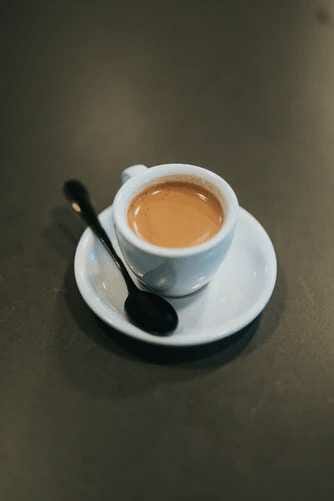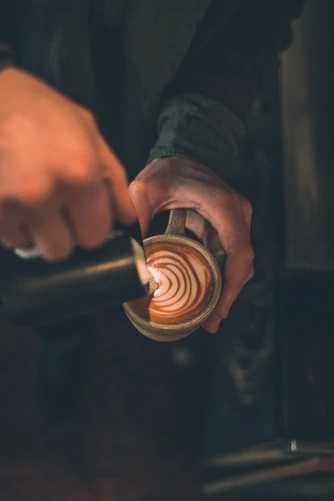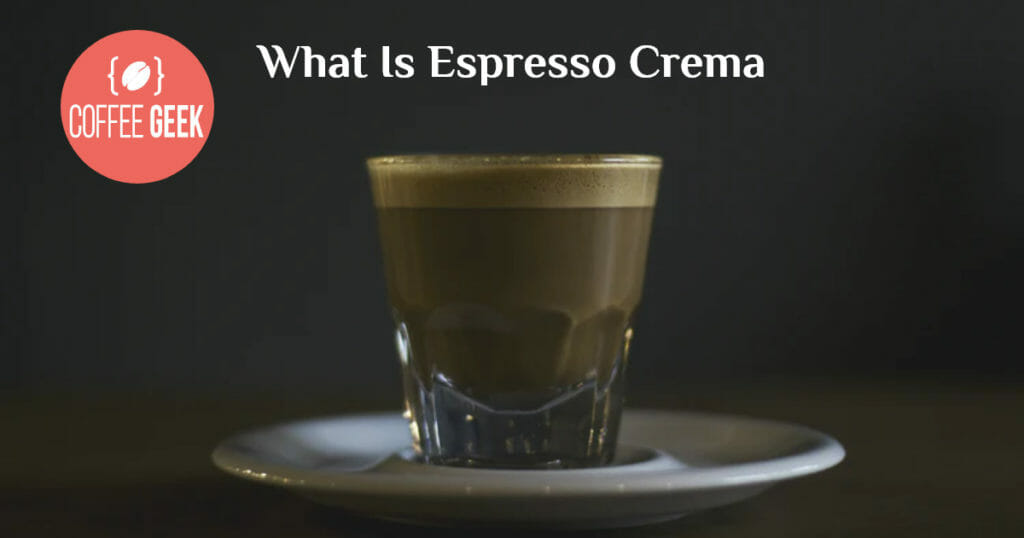You might have noticed a layer of foam laying on top of the cup of espresso you ordered at the coffee shop. You asked the barista and apparently, coffee enthusiasts call it “crema”.
Is it supposed to happen? Is it important? How do you get crema in espresso at home? Why does your espresso have no crema?
In this article, I’ll address all of your concerns about this mysterious layer of foam and some neat tricks to pull it off on your next try with the espresso machine.
What Is Crema On Espresso
At first sight, crema is the thick and aromatic layer of copper-colored froth sitting on top of the extracted very dark-brown espresso.
Some call it the Guinness effect due to the similarity to the signature white bear foam.
The contrast in color makes it easy to distinguish the two layers, especially when espresso is served in a glass.
What Does Crema Taste Like?
To answer the question from those who’ve never tried this drink, espresso crema doesn’t taste very good on its own. It’s a bit ashy and even more bitter than the espresso.
However, most argue that it envelopes the mouth palate when drunk together with espresso, giving it a fuller-bodied taste, lengthened aftertaste, and a signature lingering bitter burn.
How Is Coffee Crema Made With A Modern Espresso Machine
So, how did this come about? Let’s dial back.
During the roasting process, the beans start to release some of the carbon dioxides and will continue to do so after the roasting ceases. But it doesn’t stop there.

Once you grind the coffee beans or let hot water come into contact with the ground coffee, the degassing process is sped up.
In other words, more carbon dioxide is released than ever. This happens in every coffee-making method.
In certain cases such as using a French Press or a Pour-Over, a good barista will let the coffee “bloom”, expand and release carbon dioxide, for around 30 seconds before brewing.
Another thing to keep in mind is the natural oils in coffee beans. Coffee oils are harder to extract using other coffee brewing methods because water and oil don’t mix.
However, in espresso machines, brewing water is forced through finely-ground coffee beans under very high pressure (9 bar is the standard).
The strong flow of hot water inside an espresso machine can push both the carbon dioxide and the coffee bean oils out.
And once they hit the cup, water emulsifies with the oils and traps the carbon dioxide, creating a thick, stable, solid-looking, and creamy layer of tiny bubbles on top of the shot of espresso called crema. Essentially, it’s a type of frothy cream as it carries droplets of oils.
So espresso crema wasn’t a thing until the modern espresso machine[b] was introduced in 1948 by Achille Gaggia.
To enable a higher pressure in pulling a shot of espresso, a lever-driven machine was incorporated into the espresso machine, resulting in better-tasting coffee and good crema.
To sum up, crema is formed from brewing coffee in espresso machines and is one of the factors that set espresso apart from other types of coffee.
If you’re interested in learning more about how espresso is different from regular coffee, click here.
What Does The Perfect Crema Look Like
1. Color
The general color coffee brewers should aim for is brown that is lighter than espresso. Depending on the beans you use, the color may range from a warm light brown to medium brown.

2. Thickness
As aforementioned, crema is not tasty. So you don’t want too much of it to the point it overwhelms your perfect espresso. A good range for a good crema is around 0.25 – 0.35 inches (6.4 – 8.9 mm), or approximately 10% of the volume of espresso.
3. Stability
How long should the perfect crema stay on top? Coffee experts believe it should be able to stay on top for at least 2 minutes.
To elaborate, crema relies on thousands of bubbles and liquid viscosity. So, eventually, the limited elasticity can’t hold them all together and rupture the form, releasing the previously trapped carbon dioxide gas.
Small bubbles also tend to shrink as the water evaporates, which diminishes the stability of the whole foam structure.
However, if the crema breaks too easily, there can be a few things that affect the quality of crema such as coffee beans choices and the extraction process.
Should Espresso Have Foam
The first reason is on the tongue. As mentioned[c], a common argument is coffee crema contributes to the signature full-bodied taste.
Therefore, the presence of crema is claimed to be fairly significant to the overall flavors of the cup of espresso.
Another reason why crema is important is that it’s considered to be a relatively reliable indicator of a quality espresso.

A layer of crema that is the right color, aromatic, and thick enough suggests:
- The use of recently well-ground fresh coffee
- The skilfulness of the barista in espresso extraction
This belief has caused many coffee lovers to form a preconception about the espresso shot before even tasting it.
But it isn’t always correct. You have to drink it to know whether it is a great-tasting cup, even if it has a pronounced crema.
To give an example, the one thing crema is undeniably good at is being a good indication of freshness.
Even if the coffee tastes bad but everything going into the extraction process is fresh, you may still yield a perfect crema. So don’t be fooled by your first impression.
How Do You Get The Best Crema On Espresso
What are the factors that you should take into consideration to create an ideal crema?
1. Freshness
Fresh beans, freshly roast, and freshly grinds retain more coffee oils and gases to produce the layer of froth.
A dirty machine also won’t do you any good both in espresso flavor and crema.
If you’re struggling with creating a beautiful crema, though this isn’t the only factor that leads to better crema, pay attention to this first.
2. Coffee Beans
Which coffee beans generally produce the best crema? According to research published in Food Research International in 2018, Robusta coffee beans produce more crema than Arabica.
Therefore, a traditional shot of espresso usually comprises a blend of both Robusta and Arabica to achieve both the taste and the looks of a good crema.
However, in specialty coffee shops and roasteries, Arabica is often used as it has long been perceived to be superior in taste, which translates to potentially less crema but good espresso nonetheless.
Another reason not to judge a book by its cover.
And although Robusta creates a more pronounced crema, the froth layer has weaker stability than the one made with Arabica.

The research states that crema may persist past an hour for a double shot made of Arabica coffee beans, while Robusta can barely last 24 minutes.
3. Roast
A dark roast, or espresso roast, generally yields more crema than a medium roast, whether you pull a single shot or double shot, use Arabica or Robusta.
The same is also applicable to the fading time of crema with one exception. If you pull a single shot of espresso with Arabica coffee beans and expect a longer-lasting crema, opt for the medium roast rather than the usual dark roast.
4. Brewing Amount
The above research also mentions that brewing with a double basket or triple basket can produce more crema than a single shot due to 2 reasons:
- A larger amount of coffee releasing more carbon dioxide and foaming agents
- A higher number of holes allowing more pressure drops to induce foaming
This can be helpful if you prefer a thicker layer of crema on your espresso, be it for aesthetics or the taste.
Since each coffee lover may have a different preference and expectation for the best cup of espresso, refer to the above factors to make appropriate adjustments.
Troubleshooting Espresso Crema
If you’re still confused about why you’re getting bad crema or none at all, let’s go over some of the most common issues.
Why Is There No Crema On Your Espresso

As I’ve previously mentioned, check the freshness of your ingredients. The farther the roast and grind dates are from when you actually brew the beans, the staler they become.
You will not only lose crema but also good espresso. The flavor is likely lackluster and plainly bad.
So store your beans properly in a cool and dry place, always double-check the roast date to see whether it’s within the nearest 3 weeks, and grind your own beans if possible.
Invest in a reliable grinder to get the right grind for your holy grail of a perfect espresso. Get started by checking our most recent reviews of good burr grinders here.
Why Does Your Crema Come Out Bubbly
I know I stated that you shouldn’t use your coffee grinds too late, after 3 weeks, but using them too early isn’t a good idea either.
As mentioned before, coffee beans start to release carbon dioxide when it’s roasted and continue to do so until they turn into sludge.
Using coffee too near the roast date doesn’t allow it enough time to degas, resulting in undesirable bubbly crema.

Another reason why you got dark and big bubbles are likely due to over-extraction. Over-extracted coffee can result from:
- Too fine of a grind
- Too much coffee
- Over tamping
- Water temperature above 205 degrees Fahrenheit (96.1 degrees Celsius)
- Too long brewing time in the machine
Adjust those factors to improve your shot of espresso and the crema layer should follow suit. Ideally, there should be as few large bubbles as possible.
Why Is Your Crema Thin And Light-Colored
On the other hand, a thinner and lighter crema is usually the result of under-extraction. You might have under-extracted your shot due to:
- Too coarse of a grind
- Too little coffee
- Water temperature below 195 degrees Fahrenheit (90.6 degrees Celsius)
- Too short brewing time in the machine

But look into the freshness of your beans first. Stale coffee loses coffee oils and carbon dioxide and flavor over time so all you get will be a thin layer of crema that tastes sour and quickly dissipates.
Why Does Crema Break During Latte Art Pour
It’s hard to master latte art from the first day. But don’t worry if you break your crema when pouring steamed milk over your perfect espresso.
Here are a few tips to shoot a good shot next time:
- The angle between the hand holding the cup handle and the hand holding the milk pitcher should be a neat 90 degrees.
- Slowly pouring into the center of the cup from around a 4-inch height.
- Stop then lower your pitcher and speed up your pour to start making your planned latte art.

If you pour too fast at first, your crema may break and disappear. Once the milk and the crema have somewhat blended, lower and quicken your pour.
Or else, the crema will swallow the milk and rise to the top of the cup. And this time, it’s your latte art that breaks.
Should You Skim Your Crema
People have different preferences and crema isn’t out of the equation.
Crema is still a prevalent factor in evaluating the quality of an espresso shot. It’s also said to give the cup a fuller flavor. But not everyone necessarily agrees with this.
Some think it’s a better idea to skim it off the shot to get a smoother, cleaner, and sweeter taste of espresso.

The coating over their mouth palate and the unnecessarily bitter aftertaste aren’t their thing, either.
So, do you think this layer of froth is worth your attention so far? Do you think crema adds more dimension and complexity to your espresso or worsens it? Whatever team you’re on, focus on making tasty espresso first.

